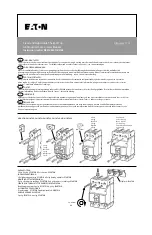
5
should be carefully studied and applied in each user's
formation of planned maintenance.
Some users may require additional assistance from GE in the
planning and performance of maintenance. Local GE Sales
can be contracted to either undertake maintenance or to
provide technical assistance such as the latest publications.
The performance and safety of all equipment may be
compromised by the modification of supplied parts or their
replacement by non-identical substitutes. All such design
changes must be qualified to the original manufacturers
specifications.
The user should methodically keep written maintenance
records as an aid in future service planning and equipment
reliability improvement. Unusual experiences should be
promptly communicated to G.E.
SECTION 2—Description
2.1—General
This section contains a description of the PowerVac
®
vacuum
circuit breaker. It also describes the functions of the electrical
and mechanical systems.
2.2—Summary Description
The PowerVac
®
vacuum circuit breaker uses sealed vacuum
power interrupters to establish and interrupt a primary circuit.
Primary connections to the associated metalclad switchgear
are made by horizontal bars and disconnect fingers,
electrically and mechanically connected to the vacuum
interrupters. Molded interrupter supports, one per phase on a
three-phase circuit breaker, provide mountings for the primary
bars, interrupters, current transfer fingers, and heat
dissipation fins (where used). The operating mechanism
provides direct motion at each phase location in order to
move the movable contact of the vacuum interrupters from an
open position to a spring-loaded closed position and then back
to the open position on command.
The ML-18 and ML-18H mechanisms are of the stored-energy
type and use a gear motor to charge a closing spring. During a
closing operation, the energy stored in the closing spring is
used to close the vacuum interrupter contacts, compress the
wipe springs which load the contacts, charge the opening
spring, and overcome bearing and other friction forces, The
energy then stored in the wipe springs and opening spring will
open the contacts during an opening operation.
Closing and opening operations are controlled electrically by
the metalclad switchgear or remote relaying. Mechanical
control is provided by manual close and trip buttons on the
circuit breaker. The closing spring may be manually charged,
and a method for slow-closing the primary contacts is
available. The mechanism will operate at the ac or dc voltage
indicated on the circuit breaker nameplate.
Mechanical and electrical interlocks are provided and are
described in Section 4.2, Interlock.
SECTION 3—Receiving, Handling and Storage
3.1—Receiving
A. Equipment Packages
Every package leaving the factory is plainly marked with the
case number, requisition number, and customer’s order
number. If the equipment has been split for shipment, the
section numbers of the equipment enclosed in each shipping
package are identified.
NOTE:
To avoid loss of any parts when unpacking, the
contents of each container should be carefully checked
against the packing list before discarding the packing material.
Contents of each shipping package are listed on the Master
Packing List. In addition, this list includes the number of the
shipping crate in which miscellaneous parts needed to install
and operate equipment (such as hardware, contact lubricant,
touch-up paint, breaker closing devices, etc.) are located.
Normally, such devices are packed in a cardboard carton and
the carton secured in an empty switchgear compartment. If
such items are packed in a switchgear section instead of a
separate crate, the list will indicate appropriate section
number in which they are stored. Large items (such as
breaker lift trucks used with indoor and outdoor equipment)
will always be shipped in separate crates or cartons.
B. Inspecting for Damage
All equipment leaving the factory is carefully inspected and
packed by personnel experienced in the proper handling and
packing of electrical equipment. Upon receipt of any
equipment, immediately perform a visual inspection to
ascertain if any damage has been sustained in shipping or if
there are any loose parts.
C. Filing a Claim
If any damage is evident, or indication of rough handling is
visible, file a claim for damage at once with the transportation
company and notify the nearest General Electric Company
Sales Office immediately. Information on damaged parts, part
number, case number, requisition number, etc., should
accompany the claim.
3.2—Handling
When lifting the breaker, use of the specially designed lift
truck is recommended. It is necessary to use the lift truck
when placing a breaker into or removing it from the metalclad
switchgear unless the breaker is equipped with a roll-in
undercarriage (bottom only) . If it is necessary to lift the
breaker with a hoist use four 1/2 inch diameter hooks rated at
least 500 pounds each. Lifting locations are provided in the
side frame members. Use a spreader wider than the breaker
to prevent slings from contacting the interrupter supports.
3.3—Storage
It is recommended that the breaker be put immediately in its
permanent location. If this is not possible, the following
precautions must be taken to assure proper breaker storage.
Summary of Contents for PowerVac GEK-86132G
Page 26: ...26 C Breaker closed spring discharged D Breaker closed spring charged Figure 16 Continued ...
Page 28: ...28 Figure 17 Continued ...
Page 29: ...29 Figure 18 Typical wiring diagram for ML 18 and ML 18H mechanisms ...
Page 38: ...Intentionally Left Blank ...
Page 41: ...Notes ...
Page 42: ...Notes ...
Page 43: ...Intentionally Left Blank ...





























